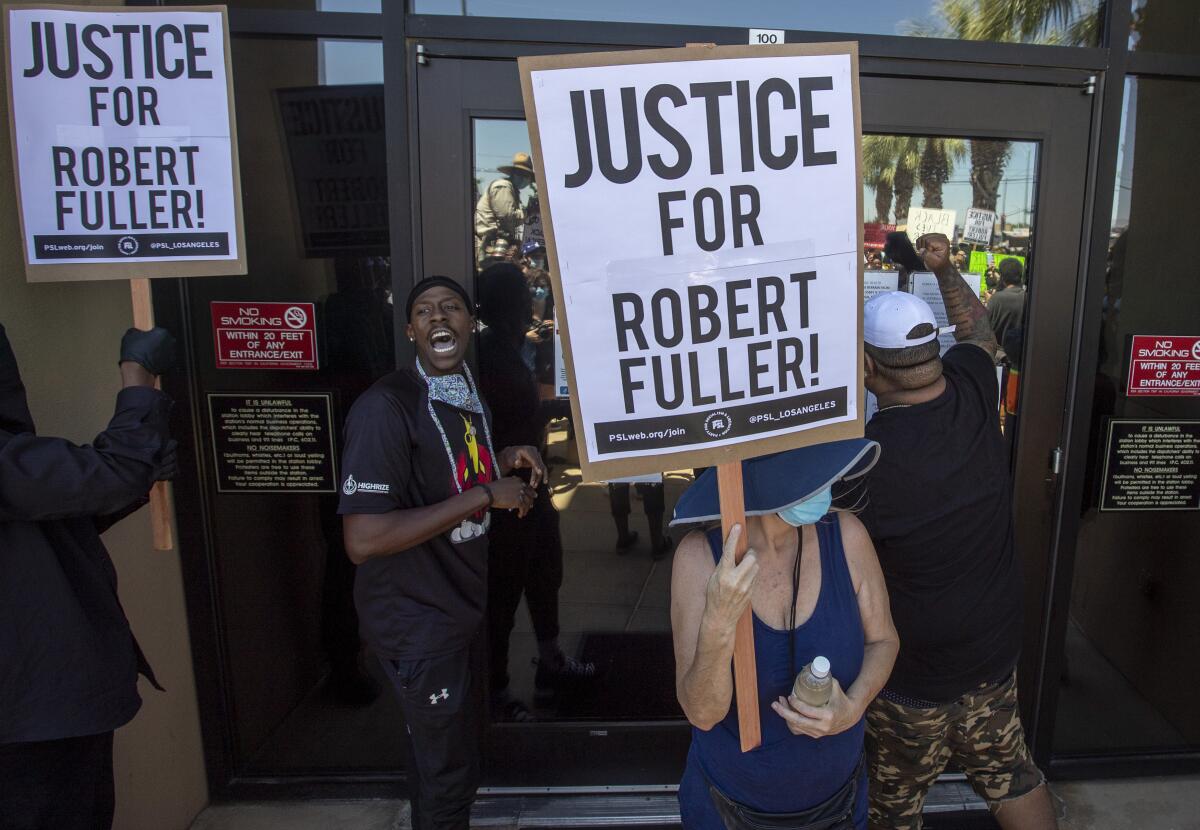Two Black men hanging from trees in Southern California? Leave no stone unturned investigating

- Share via
The image of a Black man hanging from a tree is seared into the American psyche as the embodiment of racism in all its ugliness and cruelty. Lynchings of African Americans through the civil rights era of the 1960s challenged the nation’s perception of itself as the land of liberty, justice, equality and rule of law, and we have seen to our horror that even today, racial hatred can still descend to murder.
So even if a hanging in the Antelope Valley might look at the authorities’ first glance like suicide, that simply must not be the end of it. There must be a thorough probe, and findings must be made public.
The body of 24-year-old Robert Fuller was found June 10 in a tree near Palmdale City Hall. Officials quickly labeled it a suicide, but protesters to their credit immediately demanded a deeper investigation. So did Los Angeles County Supervisor Kathryn Barger.
How likely is it that a man would hang himself from a tree? It is not unheard of, but it is hardly reassuring to note that two weeks earlier the body of 38-year-old Malcolm Harsch was found hanging from a tree in Victorville, a desert city at the opposite end of the storied Pearblossom Highway from Palmdale. Coincidence is possible. But so is a pattern. We don’t have enough information yet to know.
Until a generation ago, much of the desert just north of Los Angeles and San Bernardino was dotted with mostly white communities that attracted families seeking homes that were more affordable and a lifestyle that was less urban than what was found in the packed cities south of the mountains. They were joined in the 1980s by a large migration from L.A. of Black families. The relatively quick demographic change brought some tension and several instances of violence.
L.A. County Dist. Atty. Jackie Lacey is today vocally opposed by protesters angry that she has not prosecuted police who have killed unarmed Black men. But as a young deputy district attorney assigned to Lancaster (not far from Palmdale), she prosecuted the killers of a homeless man whom they had met at a McDonald’s. Lacey said that they had set out to kill a Black man and that, when they had done it, they celebrated by getting tattoos. Lacey won the county’s first hate crime convictions.
“Here we are in the 1990s, in Southern California,” she recounted as a candidate in 2012, “and you have a racist group that has decided to murder people much the way they did in the South and got away with it in the ’50s. The verdict was about this: We are not going back there. Justice will be served. It was a message to anyone else out there who would even think of engaging in this behavior — that we’re just not going back there.”
That’s a sentiment that ought to ring true today: We will not go back there. Those are the words that ought to be on our minds when we see the videotaped killing of Ahmaud Arbery, who was chased down this year by white men in Georgia and shot to death. We will not go back there — and yet here we are. Arbery’s killing has the look and feel of a lynching, even if in this instance there was no rope and no tree.
That was the South, but those same words echo when we see the killing of George Floyd in Minneapolis. And yes, Floyd was killed not by a lynch mob but by a police officer. Yet the brutality and gratuitousness of the killing lend it the caustic flavor of a lynching. We will not go back there, yet here we are.
People around the nation are marching in resolve and anger against the continuing individual and institutional — and deadly — anti-Black racism still ingrained in our society. We struggle with the lines that separate the killing of people like Breonna Taylor in her own home by police officers from the killing of people like Arbery by civilians.
So we do not — we must not — simply shrug and say “suicide” when Black men are found hanging in trees. We leave no stone unturned until we can determine conclusively that these men were not killed by others, but by themselves.
And then, if we conclude that it could not have been murder but must have been suicide, we must recognize that our work is not done. We will have to ask ourselves: Why would a young Black man in the 21st century United States kill himself? Suicide in the Black community was historically low but is on the rise, especially among teenagers and young adults. Where did we go wrong? And, whether it be murder or suicide, how do we prevent such a thing from happening again?
More to Read
A cure for the common opinion
Get thought-provoking perspectives with our weekly newsletter.
You may occasionally receive promotional content from the Los Angeles Times.






